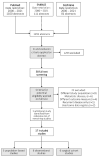The Burden of Peritoneal Metastases from Gastric Cancer: A Systematic Review on the Incidence, Risk Factors and Survival
- PMID: 34768402
- PMCID: PMC8584453
- DOI: 10.3390/jcm10214882
The Burden of Peritoneal Metastases from Gastric Cancer: A Systematic Review on the Incidence, Risk Factors and Survival
Abstract
The peritoneum is a common metastatic site in gastric cancer. This systematic review provides an overview of the incidence, risk factors and survival of synchronous peritoneal metastases from gastric cancer. A systematic search was performed to identify studies wherein the incidence, risk factors and survival of gastric cancer with peritoneal metastases were investigated. Of all 38 potentially eligible studies, 17 studies were included based on the eligibility criteria. The incidence of synchronous gastric peritoneal metastases was reviewed for population-based studies (10-21%), for observational cohort studies (2-15%) and for surgical cohort studies (13-40%). Potential risk factors for synchronous gastric peritoneal metastases were younger age, non-cardia gastric cancer, female sex, signet ring cell carcinoma, diffuse type histology or linitis plastica, T4 stage, Hispanic ethnicity and more than one metastatic location. Synchronous peritoneal metastases are commonly diagnosed in patients with gastric cancer with an incidence up to 21% in recent population-based studies. Furthermore, prognosis of patients with gastric peritoneal metastases is poor with median overall survival ranging from 2 to 9 months. The high incidence and poor prognosis require intensive research on diagnostic features and effective treatment options to improve survival.
Keywords: gastric cancer; incidence; peritoneal metastases; survival; treatment.
Conflict of interest statement
De Hingh reports an unrestricted research grant from RanD/QPS and Roche, outside the submitted work, paid to the institute. Nieuwenhuijzen and Luyer report consultancy payments from Medtronic outside the submitted work, paid to the institute. The other authors have no conflict of interest to declare.
Figures
References
-
- World Health Organisation Global Cancer Observatory. [(accessed on 26 June 2021)]. Available online: https://gco.iarc.fr/today/online-analysis-multi-bars.
-
- van Driel W.J., Koole S.N., Sikorska K., Schagen van Leeuwen J.H., Schreuder H.W.R., Hermans R.H.M., de Hingh I.H.J.T., van der Velden J., Arts H.J., Massuger L.F.A.G., et al. Hyperthermic Intraperitoneal Chemotherapy in Ovarian Cancer. N. Engl. J. Med. 2018;378:230–240. doi: 10.1056/NEJMoa1708618. - DOI - PubMed
-
- Verwaal V.J., Bruin S., Boot H., van Slooten G., van Tinteren H. 8-year follow-up of randomized trial: Cytoreduction and hyperthermic intraperitoneal chemotherapy versus systemic chemotherapy in patients with peritoneal carcinomatosis of colorectal cancer. Ann. Surg. Oncol. 2008;15:2426–2432. doi: 10.1245/s10434-008-9966-2. - DOI - PubMed
Publication types
LinkOut - more resources
Full Text Sources
Medical


